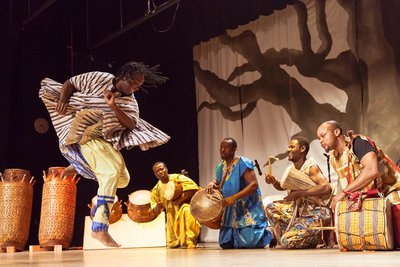
Habib Iddrisu has a slender, compact body, an unlined, youthful face and a headful of small, short dreads. The University of Oregon adjunct dance professor travels the world with traditional African singing and dance groups and actively teaches African history. But he won’t reveal his age. “I keep that to myself,” he says.
Iddrisu just returned from a month of research in his native Ghana. “I’m observing the hybridization of African music from the village to international stage,” he says. This occurs when people visit the village or when villagers leave, join the national dance company and travel, then return to the village.
“I picked two or three different music and dances that originated from my village and followed their transformation to the city center and to stages across the world,” he says. “I’ve seen a lot of development in it and I’ve also seen how these make their way back to the village, because everything is so connected now.”
Iddrisu was born into a family of court musicians and historians in the small northern Ghanaian village of Taha. His ethnic group, the Lungsi order, is one of the most powerful clans among the Dagbamba people, where music and dance go hand in hand.
“We are the most powerful because everything about our ethnic group is passed down through oral tradition,” Iddrisu says. “Even though we are not part of the ruling class, the ruling chiefs and the queens and the queen mothers rely on us to recount the history of our people, which dates hundreds and hundreds of years back. We also provide entertainment for almost every occasion, from childbirth to naming ceremonies to puberty rites, marriage and even death.”
His teaching focus is on the dance forms of the Sub-Saharan region in Africa, a large area that includes all countries south of the Sahara Desert. While the dances of Northern Africa have Middle Eastern roots, the dances of the other regions in Africa are noticeably different.
Though the dances of these many cultures have similarities, Iddrisu says they vary greatly between ethnic groups. “I’m from West Africa, which is the dance style that a lot of people in the United States are exposed to,” he says, “but in my classes I teach dances which can come all the way from South Africa.”
Iddrisu says one thing setting these dances apart is the “call-and-response” form. “West African dance forms tend to have a lot of it based on the drum call,” he says. “The lead master drummer gives the signal and dancers respond to what the drummer plays.” You may have seen him showcase this at the 2013 Dance Africa performance last winter at the UO Gerlinger Annex.
Sub-Saharan dances in general have what Iddrisu calls a “more grounded” form, in the sense that the dancers’ knees are bent and for the most part remain touching the earth. Another unique feature of dance in South Africa is that the dancers often create the music themselves, rather than following a drummer or group of musicians.
Iddrisu describes a South African dance called the Gumboot, in which the dancers wear rubber boots, known as Wellingtons, with jingles attached to them. “The dancers create the rhythm style while wearing the rubber boots with jingles attached,” he says.
Habib Iddrisu will be teaching Dance in Traditional Cultures: Ghana and African Music courses fall term at the UO.